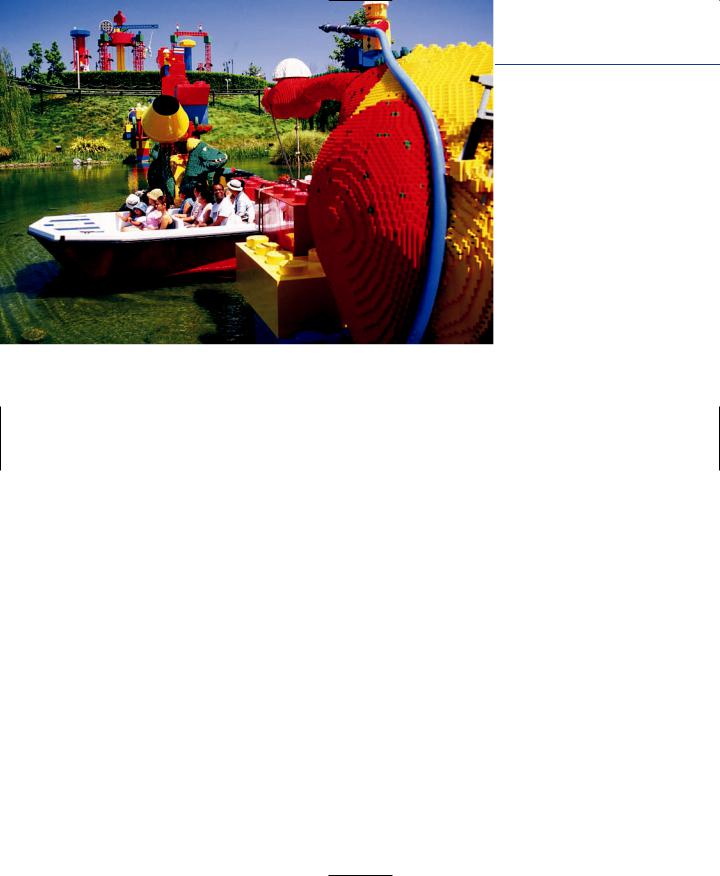
- •CONTENTS
- •PREFACE
- •Content—Benefits for Students
- •Content—Benefits for Instructors
- •Features of the Book for Students and Instructors
- •Supplementary Materials
- •Acknowledgments
- •What Is Hospitality Management?
- •The Manager’s Role in the Hospitality Industry
- •Why Study in a Hospitality Management Program?
- •Planning a Career
- •Employment as an Important Part of Your Education
- •Getting a Job
- •Employment at Graduation
- •The Outlook for Hospitality
- •Summary
- •Managing Change
- •Demand
- •Supply
- •Workforce Diversity
- •The Impact of Labor Scarcity
- •Summary
- •The Varied Field of Food Service
- •The Restaurant Business
- •The Dining Market and the Eating Market
- •Contemporary Popular-Priced Restaurants
- •Restaurants as Part of a Larger Business
- •Summary
- •Restaurant Operations
- •Making a Profit in Food Service Operations
- •Life in the Restaurant Business
- •Summary
- •Chain Restaurant Systems
- •Independent Restaurants
- •Franchised Restaurants
- •Summary
- •Competitive Conditions in Food Service
- •The Marketing Mix
- •Competition with Other Industries
- •Summary
- •Self-Operated Facilities
- •Managed-Services Companies
- •Business and Industry Food Service
- •College and University Food Service
- •Health Care Food Service
- •School and Community Food Service
- •Other Segments
- •Vending
- •Summary
- •Consumer Concerns
- •Food Service and the Environment
- •Technology
- •Summary
- •The Evolution of Lodging
- •Classifications of Hotel Properties
- •Types of Travelers
- •Anticipating Guest Needs in Providing Hospitality Service
- •Service, Service, Service
- •Summary
- •Major Functional Departments
- •The Rooms Side of the House
- •Hotel Food and Beverage Operations
- •Staff and Support Departments
- •Income and Expense Patterns and Control
- •Entry Ports and Careers
- •Summary
- •The Economics of the Hotel Business
- •Dimensions of the Hotel Investment Decision
- •Summary
- •The Conditions of Competition
- •The Marketing Mix in Lodging
- •Product in a Segmented Market
- •Price and Pricing Tactics
- •Place—and Places
- •Promotion: Marketing Communication
- •Summary
- •The Importance of Tourism
- •Travel Trends
- •The Economic Significance of Tourism
- •The United States as an International Tourist Attraction
- •Businesses Serving the Traveler
- •Noneconomic Effects of Tourism
- •Summary
- •Motives and Destinations
- •Mass-Market Tourism
- •Planned Play Environments
- •Casinos and Gaming
- •Urban Entertainment Centers
- •Temporary Attractions: Fairs and Festivals
- •Natural Environments
- •On a Lighter Note. . .
- •Summary
- •Management and Supervision
- •The Economizing Society
- •The Managerial Revolution
- •Management: A Dynamic Force in a Changing Industry
- •What Is Management?
- •Summary
- •Why Study Planning?
- •Planning in Organizations
- •Goal Setting
- •Planning in Operations
- •The Individual Worker as Planner
- •Long-Range Planning Tools
- •Summary
- •Authority: The Cement of Organizations
- •Departmentalization
- •Line and Staff
- •Issues in Organizing
- •Summary
- •Issues in Human-Resources Management
- •Fitting People to Jobs
- •Recruiting
- •Selection and Employment
- •Training
- •Retaining Employees
- •Staff Planning
- •Summary
- •The Importance of Control
- •Control and the “Cybernetic Loop”
- •Tools for Control
- •Summary
- •Leadership as Viewed by Social Scientists
- •Why People Follow
- •Leadership Theories
- •Communication
- •The Elements of Leading and Directing
- •Developing Your Own Leadership Style
- •Summary
- •A Study of Service
- •Rendering Personal Service
- •Managing the Service Transaction
- •How Companies Organize for Service
- •Summary
- •INDEX

454Chapter 14 Destinations: Tourism Generators
briefly at attractions in the natural environment, such as national parks, seashores, and monuments. Our main interest will be in the impact of these kinds of destinations on opportunities in the hospitality industry, their significance for hospitality managers, and possible careers in such complexes.
Mass-Market Tourism
It was not so long ago that travel was the privileged pastime of the wealthy. The poor might migrate, moving their homes from one place to another in order to live better or just to survive, but only the affluent could afford travel for sightseeing, amusement, and business. That condition has not really changed; some affluence is still required for recreational travel, and certainly one’s level of affluence directly affects the number and types of vacations one can take. What has changed is the degree of affluence in our society. We have become what economists refer to as an affluent
society.
When travel was reserved for the higher social classes, its model was the aristocracy. In hotels, for example, dress rules required a coat and tie in the dining room. As travel came within the reach of the majority of Americans, however, the facilities serving travelers adapted and loosened their emphasis on class. Many of the new establishments have, in fact, become mass institutions. Any discussion of these types of facilities would have to include Las Vegas and Walt Disney World in Orlando.
In Las Vegas casinos, mink-coated matrons play blackjack next to denim-clad cowboys. These are not social clubs that inquire who your parents are or which side of the tracks you live on. The color of your money is the only concern. Likewise, anybody with the money can buy a reserved seat in any of the new domed sports centers (such as Minute Maid Park in Houston with its retractable roof) or stroll through one of the new megamalls, which will be discussed later in the chapter. What we see developing (and continuing to evolve on larger and larger scales) are new “planned play environments,” places, institutions, and even cities designed almost exclusively for play—that is, pure entertainment for the masses. Again, social class is meaningless in such places— Disney World has virtually no dress code for its guests. People come as they are. All comers are served and enjoy themselves as they see fit within the limits of reasonable decorum.
These essentially democratic institutions supply a comfortable place for travelers from all kinds of social backgrounds. Accordingly, as the popularity of these facilities increases, we see a new, more egalitarian kind of lodging and food service (and other hospitality-related) institutions flourishing.

Planned Play Environments |
455 |
Planned Play Environments
Recreation is as old as society itself. However, a society that can afford to play on the scale that North Americans do now is new. Some anthropologists and sociologists argue that “who you are” was once determined by your work, what you did for a living, but that these questions of personal identity are now answered by how we entertain ourselves. Some years ago, futurist Alvin Toffler spoke of the emerging importance of “sub cults” whose lifestyles are built around nonwork activities. For these people, work exists as a secondary matter, as only a means to an end. Although there is some debate regarding the balance of work and play, play is destined to serve an increasingly important role in our civilization. We are already seeing the pleasure principle being elevated
to a higher level in our society.
To talk about a society in which leisure is the most important thing flies in the face of the work ethic and religious codes that have dominated the United States and Canada, Japan, and many countries in northern Europe for generations. It is becoming clear, however, that the new century will see a society in which leisure plays an increasingly dominant role.
Planned play environ-
ments have actually been around longer than one might believe. Fairs and festivals at which work (or trade) and play were mixed date back to the mid-1800s in the United States and to medieval times, or even earlier, in Europe. Amusement parks are anything but a twentieth-century American phenomenon—according to the International Association of Amusement Parks and Attractions, early amusement parks in Europe included Bakken in Denmark (established in the 1500s) and Vauxhall Gardens in England, built in the 1600s. In
Golf courses represent an early form of planned play environments. The golf industry is booming, causing incredible growth in the number of golf courses, both public and private. (Mission Hills Country Club; Courtesy of ClubCorp.)

456Chapter 14 Destinations: Tourism Generators
contrast, the oldest continually operating U.S. amusement park, Lake Compounce (in Connecticut), dates back to the early 1800s. Others date from the 1940s and 1950s. What is new, however, is the sophistication that a television-educated public demands in its amusement centers today, and the scale on which these demands have been met since the first modern theme park opened at Disneyland. Disneyland, in effect, showed the commercial world that there was a way to entice a television generation out of the house and into a clean carnival offering live fantasy and entertainment. That television generation has now grown up and is busy raising a newer, younger television generation or watching their children raise subsequent generations. Together, these generations are shaping the scope and nature of today’s tourism destinations.
There is a variety of leisure environments that have been artificially created for the enjoyment of tourists. These include theme parks, casinos, urban entertainment centers, and fairs and festivals. We will discuss each of these in the following sections.
THEME PARKS
In the early 1970s, a number of old-style amusement parks closed their doors because they offered little more than thrill rides and cotton candy, even as modern Americans began to demand more from their entertainment venues. Many of the old amusement parks fell in the face of more sophisticated competition from theme parks that catered more effectively to people’s need for fun and fantasy.
Many of the new themes at theme parks focus on the natural environment, such as Rhino Rally at Busch Gardens Tampa Bay. (Courtesy of Busch Gardens Tampa Bay; © 2004 Busch Entertainment Corp.)

LEGOLAND®CALIFORNIA attracts over 1 million visitors each year. (Courtesy of LEGOLAND®CALIFORNIA.)
According to industry sources, the United States has about 600 major themed attractions and other, more traditional amusement parks. The number of visitors to theme and amusement parks in 2005 was estimated at 335 million (the equivalent of more than one visit for every person in the United States), and revenues earned were just less than $10 billion.1 Worldwide, the industry is estimated to total $19 billion.2 Outside of the United States, there are about 300 amusement parks in Europe and it is a growing industry in Asia. In fact, according to the International Association of Amusement Parks and Attractions, four of the top ten grossing parks in the world are in Asia. Tokyo Disneyland, which will celebrate its twenty-fifth anniversary in 2008, draws more visitors than any other park in the world (17 million) and is successful despite the difficulty that theme parks in Japan have had over the last few years. Hong Kong Disneyland is Disney’s most recent venture in Asia.
Although fewer in number, it is the theme parks that account for the lion’s share of park receipts. These parks have clearly become an important part of both the national tourist market and the local entertainment market. In practice, though, about half the guests visit at least twice a year.
THEMES
Just as restaurants are expected more and more to offer entertainment as well as food (note the popularity of the Hard Rock Cafe and Hooters), today’s television-oriented traveler expects a park environment that stimulates and entertains in addition to offering rides and other amusements. One way to meet this demand is to build the park around one or more themes. An excellent example of this is Walt Disney World in Orlando,
457

A boat ride takes visitors by sculptures built of LEGO® blocks. (Courtesy of LEGOLAND®CALIFORNIA.)
Florida, where there are themed areas within themed areas. Most people are familiar with the different theme parks at Disney World, which include the Magic Kingdom, Epcot Center, Disney-MGM Studios, and the newest park, Disney’s Animal Kingdom. Within these different parks, however, are additional themed areas. For instance, the themed areas within the Magic Kingdom include Main Street USA, Adventureland, and Frontierland, among others.
Some parks are built around one general theme. LEGOLAND, for instance, is built around the LEGO toy that originated in Denmark. LEGOLAND California is one of four LEGOLAND theme parks around the world (Denmark, England, Germany and California); it is the only one in North America. The park has some 5,000 models built from LEGO blocks, including entire replica cities (such as New Orleans and San Francisco). The park attracts over 1 million visitors each year, mostly from southern California.
Whatever the theme, parks are known for their rides, among other things. One of the most popular types is water rides. In fact, Busch has developed a separate theme park, adjacent to its Busch Gardens in Tampa, Florida, built around water and water rides. Adventure Island, as it is called, offers 25 acres of tropically themed lagoons and beaches featuring water slides and diving platforms, water games, a wave pool, a cable drop, and much more.
Although some parks cater to nostalgia (a romantic longing for the past), others re-create the past in a more realistic way. The Towne of Smithville, in New Jersey, for instance, is a restored mid-1800s crossroads community. It offers a Civil War museum and a theater as well.
458

Planned Play Environments |
459 |
Some parks take their themes from animal life. Busch Gardens in Florida offers a 335-acre African-themed park that includes the Serengeti Plain, home of one of the largest collections of African big-game animals. It also serves as a breeding and survival center for many rare species. The animals roam freely on a veldtlike plain where visitors can see them by taking a monorail, steam locomotive, or skyride safari.
The sea offers enticing themes as well. Mystic Seaport, in Mystic, Connecticut, is designed around a nineteenth-century seaport town complete with educational and recreational activities. A quite different type of experience (also based on the sea) can be found at Sea World (also owned by Busch Entertainment), which has been successful with parks in Florida, Ohio, Texas, and California. Sea World of Florida (in Orlando) features many different live shows, including Cirque de la Mer, which is labeled as a “nontraditional circus”; the Shamu Adventure, featuring numerous killer whales; and shows focusing on other sea life such as sea lions and otters. Like many theme parks, Sea World offers organized educational tours featuring the work of Sea World’s research organization. A liberal amount of education-as-fun is found in its regular, enter- tainment-oriented shows. An official of the Disney organization summed up the theme parks’ approach to education this way: “Before you can educate, you must entertain.” Theme parks do, indeed, constitute a rich educational medium.
SCALE
Theme parks are different from traditional amusement parks not only because they are based on a theme, or several themes, but also because of their huge operating scale. As in nearly everything else, Disney leads the way here. The entire Walt Disney World (WDW) complex in Florida comprises an amazing 47 square miles and offers four distinctly different theme parks, each with its own activities, food service operations, and retail stores. The original Magic Kingdom offers seven different lands or distinctively themed areas. The Epcot Center offers Future World, featuring high-tech pavilions, and the World Showcase, which boasts representative displays from nations around the world. Disney-MGM Studios gives visitors a firsthand look at the backstage workings of a major film and video production facility. Disney’s Animal Kingdom is the latest addition. The Animal Kingdom alone, which opened in early 1998, is five times the size of Disneyland (in Anaheim, California). It includes five themed areas and celebrates animal life—quite a different venue from the other three parks in the Disney complex.
Walt Disney World also includes several smaller themed areas such as Disney’s sixacre Pleasure Island, billed as being for “young adults.” This area includes several nightclubs such as the Adventurers Club, Rock ‘n’ Roll Beach Club, Pleasure Island Jazz Company, and Comedy Warehouse. Downtown Disney, located nearby, offers shopping and dining for visitors. Also located here is the theater that houses a branch of Cirque du Soleil,

460Chapter 14 Destinations: Tourism Generators
with over 1,600 seats. Finally, one of the newer additions to WDW is the Wide World of Sports Complex. This area includes venues for various professional sporting events, such as a 7,500-seat stadium where the Atlanta Braves play during baseball’s spring training. The area also boasts a 34,000-square-foot field house and multipurpose sports fields.
Disney is also a major provider of overnight accommodations. In total, it operates 23 different lodging facilities, including campgrounds and villas, on or adjacent to the parks that are operated by, or affiliated with, WDW.
With 55,000 employees, the career significance of WDW and similar enterprises is obvious. In fact, WDW is the nation’s largest single-site employer. We should also note here that Disney’s Orlando complex represents just one portion of its operations. In recent years the company has opened theme parks in France and Japan and has plans to expand further in the Asia/Pacific area, most notably in Hong Kong in 2005.
REGIONAL THEME PARKS
Theme parks catering to a regional rather than a national market have been growing at a rapid pace in recent years. At least some of this development is attributable to the increasing cost of transportation and the pressure of economic insecurity and inflation on many incomes. The convenience, however, of nearby attractions and the fact that a visit can be included in a weekend jaunt or a threeor four-day trip is probably an equally strong force. Not everyone can take the family on an extended trip to Disney World. Regional theme parks offer an alternative to many travelers.
Roller coasters continue to be a popular attraction at theme parks both large and small. (Courtesy of Busch Gardens Tampa Bay; © 2004 Busch Entertainment Corp.)

Planned Play Environments |
461 |
Regional parks, aside from serving a smaller geographic area than parks such as Disney World, often target particular groups in their marketing. For instance, Six Flags Over Georgia offers special parties for high-school graduating classes, and its annual Gospel Jubilee features top Christian talent that might not be as popular in other regions of North America. In Pigeon Forge, Tennessee, near Knoxville, Dollywood recreates the Great Smoky Mountains of the late 1800s through crafts and country music as well as atmosphere, old-time home-style food, and rides. Dollywood has a host of special events in addition to its atractions. These include National Gospel & Harvest Celebration as well as holiday celebrations, craft competitions, and performances. There is even a church on site with nondenominational services held every Sunday. Regional parks such as Dollywood are clearly major sources of tourism: Dollywood attracts over 2 million visitors each year and is the most popular attraction in Tennessee (besides the Smoky Mountains).
Regional parks, though not as large as Walt Disney World, are not small, either. Six Flags Over Georgia, for instance, offers over 100 rides, shows, and attractions. Rides in these parks are of impressive scale. Six Flags recently added its tenth themed area, called Gotham City. One ride in this area, Batman: The Ride, is a fast-paced roller coaster that takes passengers through parts of Gotham City. This single ride’s carrying capacity is close to 1,300 passengers per hour. Another ride, Splashwater Falls, is equally as spectacular and cost nearly $2 million to build. Although not on the same scale as Disney, Six Flags Over Georgia (and the 27 other Six Flags parks) are on a scale that is large and impressive enough to draw very effectively from their respective regions. A further look at LEGOLAND, a regional theme park mentioned earlier, is provided in Industry Practice Note 14.1.
THEMES AND CITIES
By definition, theme parks are focused on a central theme or themes. Similarly, entire cities sometimes evoke a singular theme. Examples include Hershey, Pennsylvania; Cooperstown, New York; and Plymouth, Massachusetts.
When one thinks of music, Nashville, Tennessee quickly comes to mind. Nashville is hardly a one-theme town, but it is closely associated with country-and-western music. Since 1925, it has been the site of the Grand Ole Opry, the wellspring from which have poured thousands of country songs and where many of the major country music stars have gotten their start.
The rise in country music’s popularity in recent years is undisputed. The country music audience continued to increase throughout the 1990s, and even though it seems to have plateaued, country music is estimated to hold a 10 percent market share nationally (making country music the number one music format on the radio today). The

INDUSTRY PRACTICE NOTE 14.1
A Different Kind of Theme Park
LEGOLAND California, located in Carlsbad (in northern San Diego County) is a good example of a regional theme park. Organized around a single theme—LEGO blocks—LEGOLAND is referred to as “the less frenetic park.” The LEGO company was founded in 1932, and the LEGO block was invented in 1949. The company branched out into theme parks in the 1960s. The first LEGOLAND opened in Denmark in 1968, and LEGOLAND California opened in 1999. According to Courtney Simmons, manager of media relations and government affairs, the park attracts its guests primarily from within the confines of the state. Out of the 1.3 million visitors each year, approximately 70 percent come from southern California and an additional 10 percent from northern California, meaning that 80 percent of guests are from within the state. The remainder come from outside the state and country. Interestingly, many of the remaining 20 percent of visitors (coming from outside of California) come from the Chicago area. Ms. Simmons attributes this to the popularity of LEGO toys and the fact that there is a LEGO store in downtown Chicago that has proven to be very popular. Many of the international visitors come from Australia.
The park consists of 128 acres of entertainment, shopping, rides, and shows. Some of the LEGO models consist of as many as 30 million bricks. There is even a model shop where visitors can watch models being built. The attractions, rides, and models are complemented by the Big Shop (which has the largest collection of LEGO toys in the United States) and extensive food service operations. There are also numerous celebrations throughout the year, including Halloween, Christmas, New Year’s Eve, and U.S. Independence Day. Their New Year’s celebration, which starts at 6:00 P.M., includes music and dancing and the LEGO “brick drop.”
LEGOLAND California has won numerous awards as being one of the best family-oriented theme parks in the United States and has become an important part of the LEGO corporate portfolio. A new park, the fourth, recently opened in Germany. It is estimated that theme parks contribute approximately 15 to 20 percent of the company revenues.
popularity of country-and-western music (some of which is becoming closer to rock) is probably a function of many factors, including the aging of the baby boomers. As the boomers, with babies of their own, turned off hard rock and heavy metal, they began to explore country music’s more traditional themes. Country music saw a large increase in listeners with the emergence of Garth Brooks in the early 1990s, and entertainers such as Faith Hill and Carrie Underwood help to maintain its popularity.
Music fans not only listen to country music on their stereos but also enjoy hearing it live. Although the Grand Ole Opry is the best-known aspect of the country music scene centered in Nashville, it is only one part of the larger Opry Mills complex, formally Opryland USA. The area encompasses 1.2 million square feet of entertainment and shopping. The complex is operated by Gaylord Entertainment.
462

Planned Play Environments |
463 |
On one side of the complex is the Cumberland River, where the General Jackson, a giant four-deck paddle-wheel showboat, docks. The General Jackson operates lunch and dinner cruises and “tailgate” parties on days on which the Tennessee Titans play. On the other side is one of America’s most successful convention hotel properties, the 2,884-room Opryland Hotel. The hotel includes 600,000 square feet of meeting and convention space. The famous Grand Ole Opry is also part of the complex and is housed in a 4,400-seat auditorium, complete with its own radio station, which broadcasts to 30 different states. Rounding out the attractions at Opry Mills are 200 retail outlets and restaurants.
The Opryland Hotel, on the other hand, draws from a quite different market than does the rest of the complex. Its business is driven primarily by conventions—80 percent of the hotel’s customers, an upscale market, are there to attend conventions, meetings, and trade shows. Although country-and-western music, and the fun that goes with it, is an important plus to this market, it is not the main draw. Rather, the key is the hotel’s extensive facilities; the hotel claims more meeting, exhibit, and public space than any other hotel in the United States. The Opryland Hotel’s size means that it can accommodate 95 percent of U.S. trade shows and exhibitions, and the property’s luxurious public facilities, guest rooms, and excellent service are another draw. The Opryland Hotel itself resembles a theme park at times, complete with a conservatory, a water-oriented interior courtyard called the Cascades, and lots of indoor greenery. Within these areas, which are covered with acres of skylights, and elsewhere in the hotel are situated numerous restaurants and lounges, 30 retail shops, 600,000 square feet of meeting space, and various fitness facilities including swimming pools, a fitness center, and tennis courts.
Opry Mills is a clear case of synergy between attractions, entertainment, retail shopping, and communications media that has created a major international tourist attraction. At the same time, it is a vital part of the local economy. Although Nashville and the Opry Mills complex are clearly leading the way, other cities that have made country music a major tourist attraction are Branson, Missouri, and Myrtle Beach, South Carolina.
EMPLOYMENT AND TRAINING OPPORTUNITIES
CAREERS IN HOSPITALITYQ
The growth of theme parks (and themed entertainment destinations) is a favorable development for hospitality students because of the opportunities they offer for employment and management experience. Theme parks often operate year round, but on a reduced scale from their seasonal peak. Others close for several months of the year, particularly those in the northeastern United States and Canada. For others, business fluctuations can be extreme, as is the case at Paramount Canada’s Wonderland (in Ontario), which has
